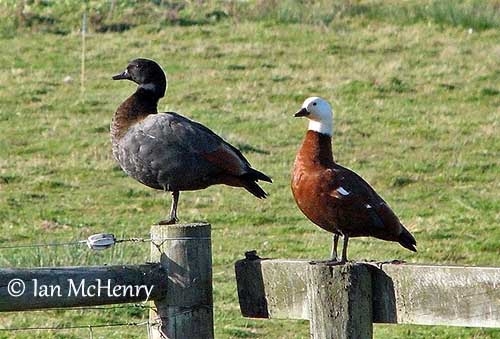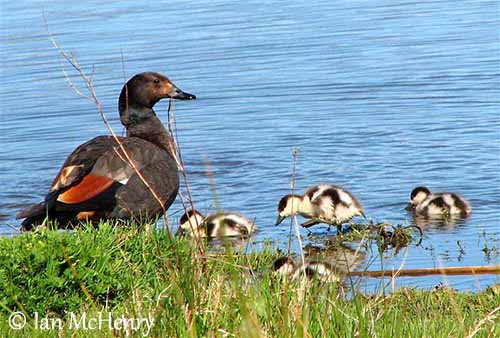
Paradise Shelduck
Tadorna variegata
Anseriforme Order – Anatidae Family
BIOMETRICS:
Length: 63-71 cm
Weight: M: 1700g – F: 1400g
LONGEVITY : Up to 23 years
DESCRIPTION:
Paradise Shelduck is endemic to New Zealand and lives only there. This species was discovered by Captain Cook in 1773, and he named it “Painted Duck”.
Adult male has dark grey body, finely barred with pale brown. It keeps the same colour all year round, even after moulting. Rump and uppertail are black. Wing coverts are white. Flight feathers are blackish. Secondary feathers are glossy green, and tertials are orange chestnut.
Underparts are brown. Undertail feathers are black. Underwing coverts are white, with blackish flight feathers.
Head is black with greenish gloss. Bill is dark grey. Eyes are brown. Legs and webbed feet are blackish.
Fr: Tadorne de paradis
All : Paradieskasarka
Esp : Tarro Maorí
Ital : Casarca del Paradiso
Nd : Paradijscascara
Russe : Райская Пеганка
Photographers;
Ian McHenry
My New Zealand Birds
Patrick Ingremeau
TAMANDUA
Text by Nicole Bouglouan
Sources:
HANDBOOK OF THE BIRDS OF THE WORLD vol 1 by Josep del Hoyo-Andrew Elliot-Jordi Sargatal - Lynx Edicions - ISBN: 8487334105
GUIDE DES CANARDS, DES OIES ET DES CYGNES – de Steve Madge - Delachaux et Niestlé - ISBN: 2603013769
Wikipedia (Wikipedia, The Free Encyclopedia)
New Zealand birds and birding (Narena Olliver)

Adult female has orange chestnut body with fine dark vermiculations on mantel. Head and neck are pure white.
Female in eclipse has darker body.
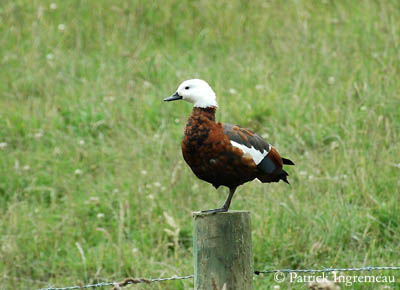
HABITAT:
Paradise Shelduck lives in varied habitats. It is found in grassy river flats, lakes and estuaries or sheltered bays, but also in pastures where these birds are abundant.
RANGE:
Paradise Shelduck is found in New Zealand, except in northern part of Ile du Nord (North Island).
BEHAVIOUR:
Paradise Shelduck is commonly seen in pairs, feeding in pastures on seeds of grasses, insects and earthworms. It also feeds aquatic plants in lakes, and molluscs and crustaceans in estuaries. It swims very well, and feeds by dabbling and grazing.
Paradise Shelduck pairs are very territorial. They occupy and defend it for life, except the time spent at communal moulting sites. It is the moment when Paradise Shelduck are killed by hunters. Birds are very fat and almost flightless, and numerous ducks and shelducks are taken. They are prized game birds.

Paradise Shelducks mate for life, and remain together from year to year. They return to the same nesting area.
When threatened, it flies off, while it utters trumpeting honks.
FLIGHT:
Paradise Shelduck performs slow wing beats when takes off. When weather is snowy, they fly in goose-like formation, in V, for gathering on lagoons. Their prominent white patches on wings are conspicuous in flight.
REPRODUCTION:
Paradise Shelduck breeds from August to December.
Nest may be situated in varied locations such as hollow in fallen tree, burrow in the ground, beneath tree roots, under logs, in thick clump of tussock, or in rock crevice. When in tree, nest is at about 25 metres from the ground.
But nest may also be a just scraped depression, or shallow bowl of grasses. It is lined with down, plucked from the duck’s own body.
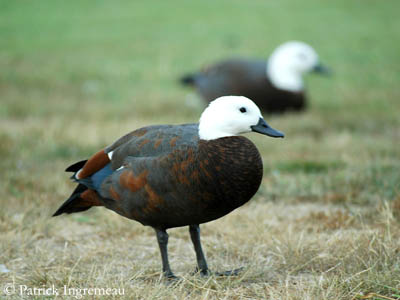
DIET:
Paradise Shelduck feeds on seeds from grasses, clover and grain, but also consumes insects and earthworms. In estuaries, it feeds on crustaceans and molluscs, and on aquatic vegetation in grassy rivers.
PROTECTION / THREATS / STATUS:
Clearing of forests for pastures is good for Paradise Shelduck. This species is widespread in most parts of its range.
Some introduced predators, such as stoats and polecats threaten local populations.
Paradise Shelduck are killed by hunters, but its numbers remain stables.
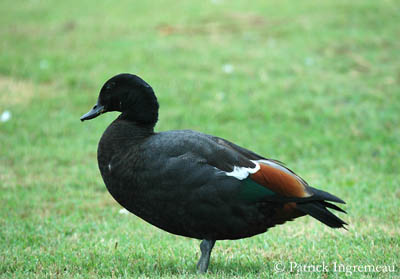
Juvenile male resembles adult, but duller and browner.
Juvenile female resembles young male, but with some reddish on breast and mantel, and whitish feathers on the head.
They start to breed at two years.
VOICE: SOUNDS BY XENO-CANTO
Paradise Shelduck utters trumpeting, goose-like “honk” while it flies off if threatened. Usually, male utters guttural “glink-glink” sounds, low grunts, and a kind of guttural “ha-hu” during displays.
Female utters loud, discordant calls.
